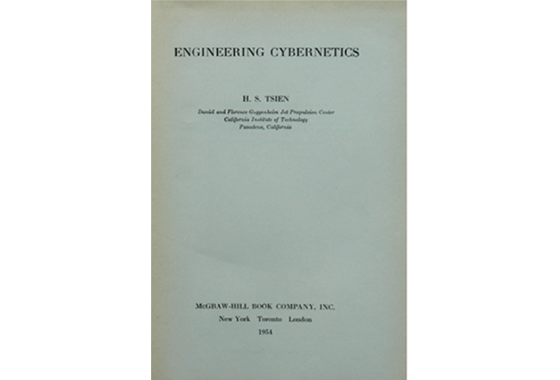“Place Two Wheels on One Chariot”-Proposing “ Engineering Cybernetics”
2015年09月28日

McCarthyism fever prevailed in the United States in 1950, affecting Qian Xuesen’ s academic research over rocket jet propulsion and other confidential projects. In order to divert the attention of American spies, and return to China as soon as possible, Qian Xuesen changed his “Profession” to study other theories.
During the days of his detention, Qian Xuesen did not stop academic study, but instead made two significant achievements, one is opening up “Physical Mechanics” and the other is proposing “Engineering Cybernetics”.
American mathematician Norbert Wiener brought up cybernetics for the first time in his academic works in 1948. Qian Xuesen subtly sensed its importance, connected it with his own experience in rocket development, and made further development and innovation for that theory.
In 1953, Qian Xuesen set up the “Engineering Cybernetics” course, knitting mechanics, electromagnetism and information science closely together, and applied them to exploring how to realize automation and self-regulation in the complex engineering field.
In the next year, the book of “Engineering Cybernetics” was published, drew much attention from the international scientific and technological circles and even the field of philosophy, and was translated into many foreign languages, such as German, Russian and Czech, triggering a wave of “cybernetics fever”.
An American columnist once commented, “engineers care about practice and solve specific problems; mathematicians are good at theoretical analysis rather than solving practical problems from the general to the specific. While Qian Xuesen owns these two advantages, he is highly skilled at placing two wheels on one chariot, opening up a new path for engineering cybernetics study.”
Untold Story:
After his return to China, Qian Xuesen organized an “engineering cybernetics” tutorial class to publicize this theory in Chinese scientific circles. On January 24, 1957, his work “Engineering Cybernetics” won the first prize of the 1956 Annual Science Award issued by the Chinese Academy of Sciences.
It was the first time that New China had set up the highest national natural science award, which was presented by Guo Moruo, director of the Chinese Academy of Sciences. The next day, Qian Xuesen’s acceptance speech titled “Accept the Science Bonus with great excitement” was published in the People’s Daily Report. He stated he had much gratitude for our nation and people, and emphasised that, “ultimately, the bonus belongs to the 600 million people”.
In 1958, the Chinese edition of “Engineering Cybernetics” was published. In the following 20 years, with the development of Chinese missile technology, modern cybernetics theory, the research over the engineering cybernetics has been making progress.
In 1980, the revised edition of “Engineering Cybernetics” was published, including five new chapters with various new thoughts and new theories. Gao Weibing, auto-control theorist, member of the Chinese Academy of Sciences once stated, “‘Engineering Cybernetics’ is a book with the highest citation rate in the field of auto-control science.”
The Engineering Cybernetics is an “emerging science studying the general law of information and control”, forms an important cornerstone for the engineering cybernetics theory, and also provides clear directions for the development of automation technology. Especially in the 18th chapter of this book, Qian Xuesen discussed the concept of how to shape a highly reliable system with relatively unreliable elements.
This action has gone far beyond the study object of the auto-control theory at that time, and entered the scope of systematics. Therefore, “Engineering Cybernetics” has been regarded as the first milestone in the development of systems science, which also laid a solid foundation for Qian Xuesen to make huge success in his later years.
